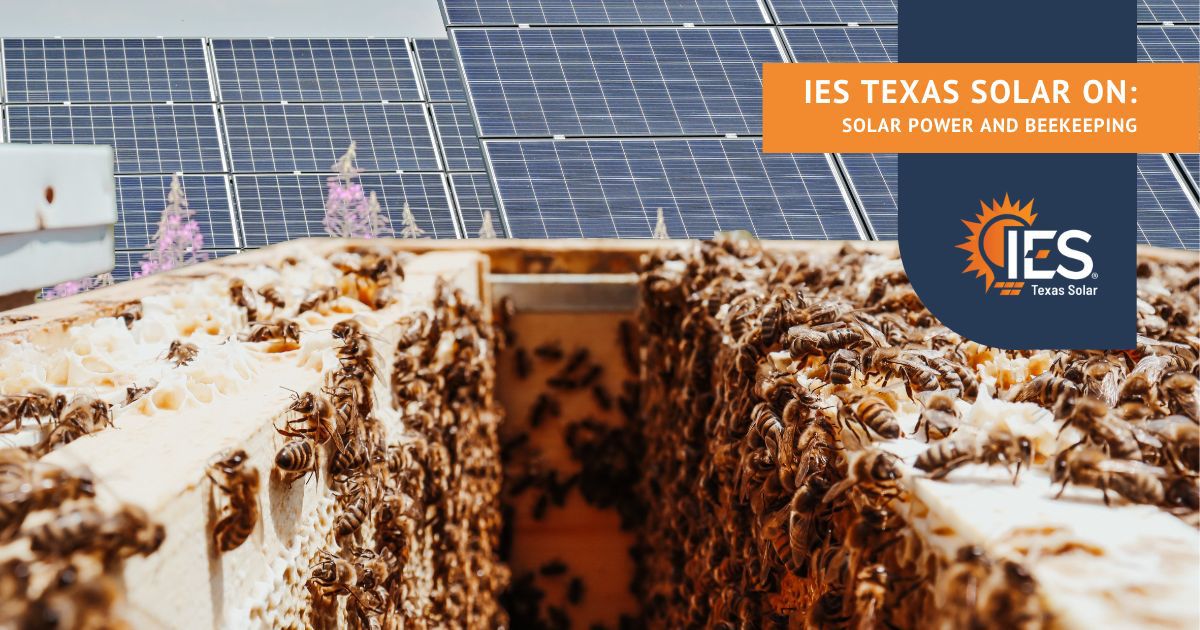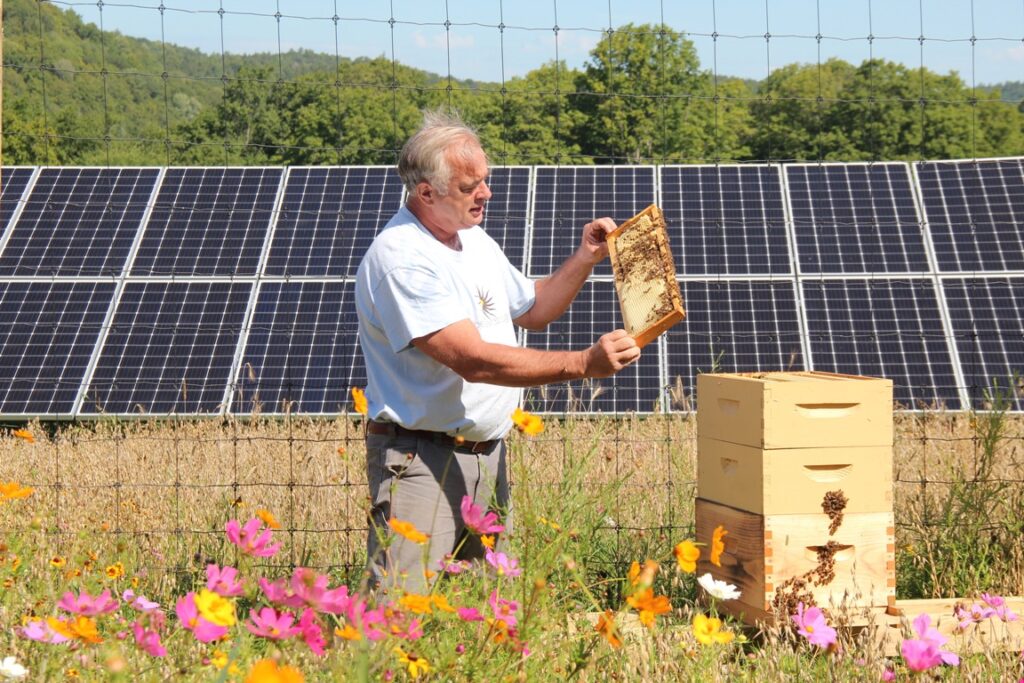
Time to read: 6 minutes
November 29, 2022
Solar power is associated with going green, cutting electricity bills, and giving its users a reliable way to power their home. Now there’s another way that customers are using solar power.
BEElieve it or not, beekeeping is popular with solar farms
Beekeeping has skyrocketed in popularity over the last few years. Many who keep bees as a hobby do so in order to harvest their honey for themselves or to sell it. While there is a bit of contention on the topic of conservation, many beekeepers cite improving the environment as another reason that they chose to raise honeybees. Now there are larger farms that have combined solar power with beekeeping to create unique types of apiaries (large collections of beehives).
If this sounds similar to our articles in the past on agrivoltaics, then it definitely should! Combining solar power with beekeeping is a type of agrivoltaics. These innovative farms are beginning to appear in many places around the world, including many parts of the U.S. While other types of agrivoltaic installations set up their solar arrays with livestock like cows and sheep in mind, these farms set up their panels in a way that works in harmony with beehives and other things on the farm.

How does beekeeping work with solar panels?
On many of these incredible farms, the bee hives and solar arrays are set up in a way that benefits both of them. The solar arrays are ground mounted with the beehives placed in the area around them or beneath them. This reduces space on the farm by combining the two in the same space.
The areas around the beehives and solar panels are filled with flowers that the bees feed on and need for honey production. Many, if not all, of the beekeepers that run these solar/bee farms focus on not just using solar as an effective renewable energy source, but on increasing the amount of pollinators like the bees that they raise.
Combining these two things helps use the extra space on a farm that otherwise wouldn’t be utilized for anything. Companies like Bolton Bees have been using solar beekeeping to produce their own brand of honey called “Solar Honey”. Bolton Bees host 10 solar farms in Minnesota that cultivate bee hives and also spend time in Texas during the winter to raise queen bees. According to Travis Bolton in a recent article by Beaumont Enterprise, “It’s become a common practice in Minnesota and Michigan for solar farms to be multipurpose”.
Another honey farm company that has been using solar arrays with their beekeeping is Bare Honey, a Minnesota based honey farm that is made up of solar arrays and beehives. Like Bolton Bees, Bare Honey also plants pollinating flowers around the beehives and solar panels. The US isn’t the only place that is seeing a steady adoption of this blending of technology and agriculture.
Across the Atlantic Ocean, the town of Carmona in Spain has been able to significantly improve their bee population as well as their honey production. This particular example is a bit different from traditional farms. This facility is the result of the solar plant project run by the Endesa energy company and is made up of a whopping 250,000 solar modules (enough to power 30 thousand homes according to Interesting Engineering), a little over seven acres of aromatic plants, and between 50 to 60 beehives.
The apiary is set in a large area full of wildflowers that were planted between the solar panels and grown without the use of pesticides or other chemicals. What sets this apiary apart from the more traditional ones that have been paired with solar arrays is that these beehives are monitored from a control center that enables the farmers to watch and control the humidity and temperature of the bee hives.
Why has there been a surge in beekeepers combining solar power with their beehives?
This is one of the big questions. Why now? There are a few reasons that there seems to be more solar apiaries appearing in the US over the last few years, and much of it has to do with laws in Minnesota. Back in 2016, the Pollinator Friendly Solar Act was signed into law. This act created standards for managing a native habitat for beneficial plants and animals in an ecosystem. Solar power providers viewed this as an opportunity for growth, and it certainly paid off.
By creating more solar arrays in Minnesota in line with the Pollinator Friendly Solar Act, Minnesota experienced a massive increase in solar power. These sites had native flowers and grasses planted once the solar arrays had been completed, making the sites into not just dynamos of renewable energy, but habitats that will improve the ecosystem by providing for pollinators. This led to partnerships between local beekeepers and energy companies. In fact, Connexus energy partnered with Bolton Bees, making Connexus the very first solar energy provider to have a commercial bee operation. Now there are several solar apiaries in Minnesota with more on the way in many parts of the US.
Another reason for the increase in combining beekeeping with solar energy is that more people are conscious of the decrease in pollinators like bees, butterflies, and birds and the negative effect that their increased absence has. This increased awareness has led to many people (especially in Texas) to begin planting wildflowers or to pick up other activities that help out the environment.
Finally, solar power saves money not just for farmers but everyone that wants to save money on their electricity in a way that helps the environment. Pairing that up with beekeeping (especially when you can sell your honey as a side-hustle) lets people double-dip on going green.
Here is a quick breakdown of how these unique farms are set up:
- Solar arrays are ground mounted in areas with plenty of sunlight
- Flowering plants are planted in the same areas that the solar arrays are installed. Being that these spaces get plenty of sunlight, the plants and flowers are able to thrive.
- Beehives are set up close to the solar arrays
- The bees are able to access all the pollinator-friendly plants they need and produce honey. These bees are also a massive benefit to crops that depend heavily on them to flourish.
Being that solar panels have an incredibly long lifespan, this type of farm is extremely beneficial for both farmers and the environment. The farm creates a good deal of its own electricity through the solar arrays, which also provide an area for flowering plants and beehives that benefit pollinator dependent crops. This is a very sustainable model for this type of farm, and acts as a shining example of what an agrivoltaic farm looks like.

Why Texas is perfect for solar beekeeping
With the amount of sunshine that Texas gets, farms of all types stand to greatly benefit from installing a solar powered system. Texas itself produces quite a bit of honey on its own. According to AgriLife Today, Texas honey production topped a whopping 7.4 million pounds. As for the numbers on commercial honey bee farms, the Texas Beekeepers Association, there are around 300 commercial beekeeping operations in Texas. On top of that, Texas gets sunshine all year round, meaning that it’s a winning combination for both the environment and your electricity needs.
Solar power can be sweeter than honey
Solar power can help you cut down on or even eliminate your electric bill. Whether you install a solar powered system for your home, business, farm, or ranch, going solar can help both your wallet and the environment. With backup power options like backup batteries and Generac® home standby generators, power outages will never be your problem again.
If you are considering switching to solar for your home or business, reach out to us by going to our website, iestxsolar.com, or by giving us a call at (855) 447-6527.
Sources:
https://interestingengineering.com/innovation/solar-panel-honey-photovoltaic-beehives
https://www.smithsonianmag.com/innovation/solar-power-and-honey-bees-180964743/
https:// fresh-energy.org/solar-beekeeping-goes-global
https://www.beaumontenterprise.com/news/article/Beekeepers-Texas-solar-farms-17601295.php